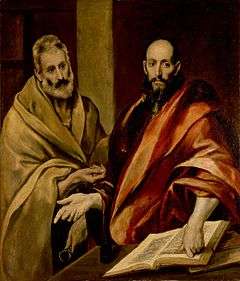Feast of Saints Peter and Paul
| Saints Peter and Paul | |
|---|---|
 | |
| Official name | Feast of Saints Peter and Paul, Solemnity of Saints Peter and Paul |
| Observed by |
Orthodox Church Roman Catholic Church Rome[1] Ticino, Switzerland Malta |
| Date | 29 June |
| Next time | 29 June 2017 |
| Frequency | annual |
The Feast of Saints Peter and Paul or Solemnity of Saints Peter and Paul is a liturgical feast in honour of the martyrdom in Rome of the apostles Saint Peter and Saint Paul, which is observed on 29 June. The celebration is of ancient origin, the date selected being the anniversary of either their death or the translation of their relics.[2]
Orthodox Catholic tradition
For Eastern Orthodox and some Eastern Catholic Christians this feast also marks the end of the Apostles' Fast (which began on the Monday following All Saints' Sunday, i.e., the second Monday after Pentecost). It is considered a day of recommended attendance, whereon one should attend the All-Night Vigil (or at least Vespers) on the eve, and the Divine Liturgy on the morning of the feast (there are, however, no "Days of Obligation" in the Eastern Church). For those who follow the traditional Julian calendar, 29 June falls on the Gregorian calendar date of 12 July.
In the Russian Orthodox tradition, Macarius of Unzha's Miracle of the Moose is said to have occurred during the Apostles' Fast and the Feast of Saints Peter and Paul that followed it.
Roman Catholic tradition
In the General Roman Calendar, the celebration is a solemnity. In earlier editions, it was ranked as a Double (Tridentine Calendar), Greater Double (e.g., General Roman Calendar of 1954), or First-Class Feast (General Roman Calendar of 1960).
It is a holy day of obligation in the Latin Church, although individual conferences of bishops can suppress the obligation.[3] In England, Scotland and Wales the feast is observed as a holy day of obligation while in the United States and Canada, it is not. In Malta it is a public holiday and in Maltese known as L-Imnarja.
On this feast, newly created metropolitan archbishops receive from the pope the primary symbol of their office, the pallium.
Ecumenical importance
In recent decades, this feast, along with that of Saint Andrew, has been of importance to the modern ecumenical movement as an occasion on which the pope and the Patriarch of Constantinople have officiated at services designed to bring their two churches closer to intercommunion. This was especially the case during the pontificate of Pope John Paul II, as reflected in his encyclical Ut Unum Sint.
Among Doukhobors
Although the Doukhobors do not venerate saints, the Feast of St. Peter and St. Paul has traditionally been a day of celebration for them. Since 1895, it has acquired a new significance as a commemoration of the "Burning of the Arms", the Doukhobors' destruction of their weapons, as a symbol of their refusal to participate in government-sponsored killing.[4] It is celebrated now by their descendants as simply "Peter's Day", sometimes referred to as the "Doukhobor Peace Day".[5]
Public holiday
The feast is observed in Rome because St. Paul and St. Peter are patron saints of the eternal city. It is also a public holiday of the Canton of Ticino, Switzerland, as well as parts of the Swiss cantons of Lucerne and Graubünden.
See also
- Incident at Antioch, a dispute between Peter and Paul
References
- ↑ "Festa di San Pietro e Paolo a Roma". www.regioni-italiane.com.
- ↑ The Catholic Encyclopedia, Volume XI (Robert Appleton Company, New York, 1911), s.v. "St. Paul", accessed 4 June 2007.
- ↑ Codex Iuris Canonici (1983), canon 1246.
- ↑ Tarasoff, Koozma J. "Historic 1895 Burning of Guns: descriptions, selections and translations". Spirit-Wrestlers.com. Retrieved 23 June 2016.
- ↑ Tarasoff, Koozma J. The Doukhobor Peace Day
External links
| Wikimedia Commons has media related to Peter and Paul Day. |
- The Holy Glorious and All-Praised Leader of the Apostles, Peter & Paul Icon and Synaxarion of the Feast (Orthodox)
